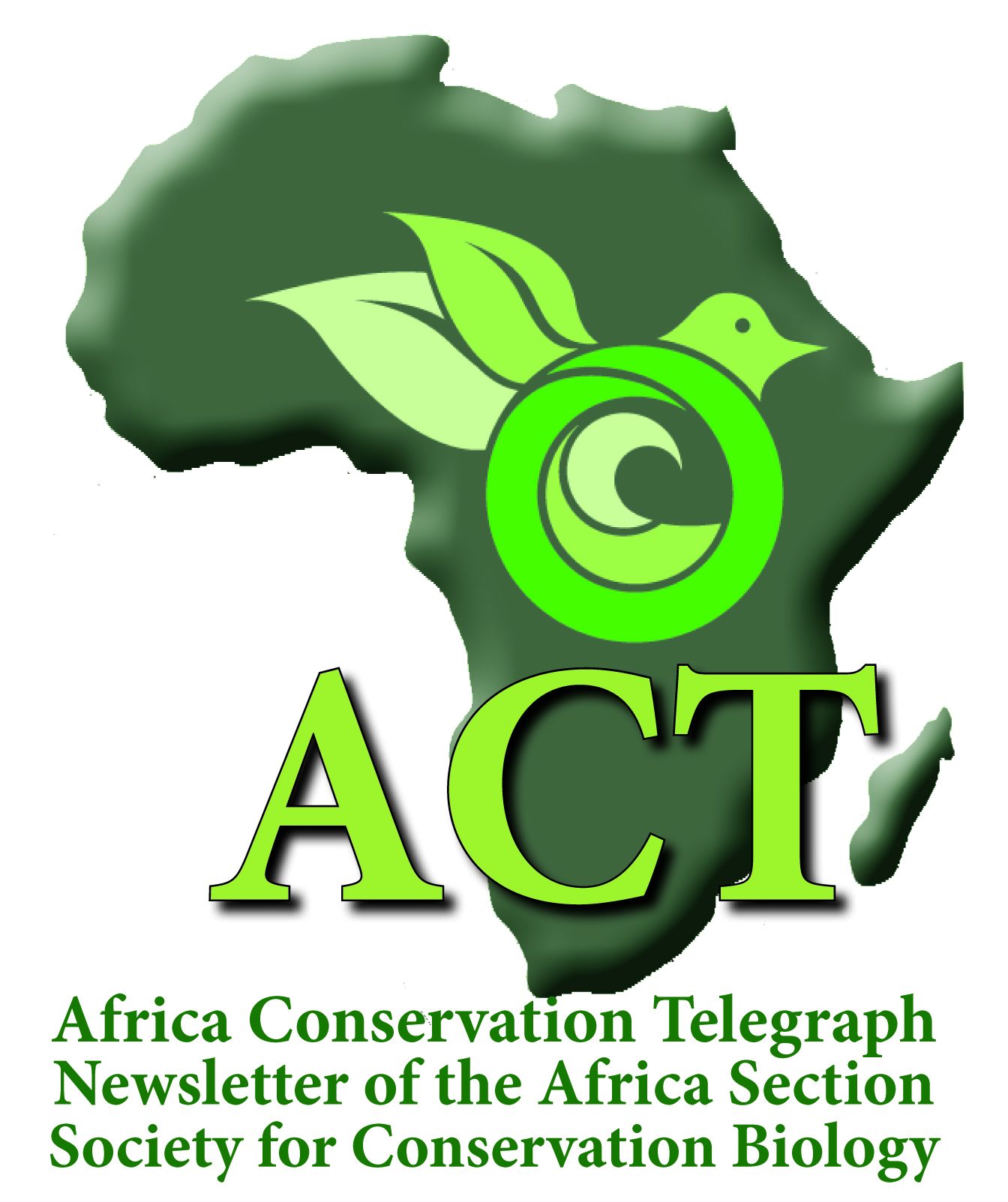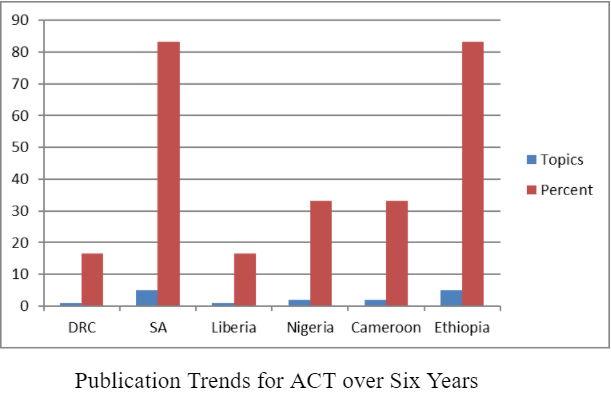ACT With a Difference

ACT. Credit: SCB Africa Section
By Murali Pai
The African Conservation Telegraph (ACT) was started by the founding members of the Society for Conservation Biology (SCB) Africa Section in 2008, with Janette Wallis as its first editor. I took over a refurbished ACT in early 2014, and here we are dealing with the seven-year-itch. We have had a good run with four issues per year, and at least 100 authors have published with us over these years making ACT a labour of love.
The Africa Section has 1000 members representing stakeholders from local communities, regulatory agencies, academia, and conservation NGOs across the world. An important metric of success for a media product like ACT is viability and keeping pace with the times. Having completed six years of existence with its niche as an e-journal for environmental conservation in Africa, ACT trundles on with a renewed sense of purpose.
The impacts of urbanization and infrastructure development in Africa are not apparent in the short term. It behoves conservation groups and responsible media like ACT to sensitize the stakeholders to the environmental impacts of mega projects like the Grand Renaissance Dam being built by Ethiopia on the Nile to the discomfiture of Sudan, South Sudan, and Egypt.
There is a space and need to publish environmental initiatives from frontline field personnel who do small things to make a big difference for conservation. A recent analysis of paper submissions to the e-journal shows six countries have taken to ACT, and we need to get the rest 48 countries follow suit, of which 21 are francophone. Clearly, the ACT would be welcome in French.
The first place (most topics and highest percentage of paper submissions) was shared by Ethiopia and South Africa. In the second place was held by Nigeria and Cameroon in West Africa, followed by Democratic Republic of Congo (DRC) in Central Africa, and Liberia in North Africa.
The way forward is to revisit the target audience of ACT who would follow the e-journal for its content, impact, and continuity. They comprise of Civil Society Actors (CSA) who likely follow environmental issues that matter to them. For e.g., a researcher in Nigeria wrote about sound pollution near mining areas in Nigeria with a personal note how it disturbed her own peace and studies because she lived in the vicinity of a mine. So, the editorial team requested this person to write about the sound pollution and we received a paper with good data on this serious issue. Therefore, a society’s ability to identify and solve environmental issues is environmental protection in practice (OECD, 1994.) However, there is no point in sending out a call for papers on marine environmental issues to the 16 landlocked countries in Africa starting from Mali in the West and going South to Botswana, and neither would readers in these countries be all agog about reading this special issue.
The moot question is how has ACT influenced public perception on policy agendas? How successful is the construction of environmental issues reported by the ACT? Shanahan et al. (2011) suggest policy narratives are influential on public opinion in two ways. First, they “preach to the choir” when read by audiences with similar opinions; the result is a significant strengthening of congruent reader opinions. Second, they “convert” when read by audiences with divergent opinions; the result is a significant strengthening of opinion in the opposite direction of previously held opinions.
Therefore, ACT must never hesitate to take the bull by its horns and persist with the narrative of publishing environmental stories that are germane to the pan-African environmental context, including investigating environmental offences committed by those businesses, factories, mines etc., that exploit local people by ##### labour by not adhering to environmental norms. In fact, DRC’s economy is partly run by such violators who pay ‘hush money’ to run shady businesses (Ruppel & Bwiza, 2013). ACT does not have the wherewithal for investigative journalism and a lack of exposé gives ACT no teeth in reporting environmental offenses.
The uncertainty of gauging environmental issues liked by readers is compounded by the digital nature of ACT because research has shown that digital media is a messy landscape for any meaningful measurement of audience preferences (Graves & Kelly, 2010). A path to viable and effective digital journalism would include:
- Educating journalists to navigate the chaos of data about online audiences, and about journalism on the Internet.
- Developing resources to help journalists understand the impact of their work, beyond counting “eyeballs” — measures of how news travels and what effect it has had on the target audience.
- Producing much‐needed research on emerging business models for professional journalism (Graves & Kelly, 2010).
Considering the ACT is sustained by people who seem to be ‘outside’ the environment to speak on ‘inside’ the environment, they would need to catch up with current trends in environmental journalism to up the ante on ACT’s scope and reach.
What environmental problem would be the focus in the next issue of the ACT is always a dauting task. Hannigan (1995) identifies six major factors necessary for the successful construction of an environmental problem.
- Scientific authority for and validation of claims.
- Existence of ‘‘popularisers’’ who can bridge environmentalism and science.
- Media attention in which the problem is ‘‘framed’ ’as novel and important.
- Dramatization of the problem in symbolic and visual terms.
- Economic incentives for taking positive action.
- Emergence of an institutional sponsor who can ensure both legitimacy and continuity (Hannigan,1995).
Climate change is one of the most pressing issues the media has taken up to play a key role in shaping public perceptions and policy agendas (Anderson, 2009).
The unique relationship between journalists and residents in small communities is also relevant and less thoroughly examined (Arenberg & Lowrey, 2018), and a lack of infrastructure i.e., power and internet could be another reason that precludes ACT’s reach smaller communities which have a bigger stake in environmental issues that bedevil Africa.
In conclusion, the intersection of media-CSA-environmentalism can only work well under a sound theoretical framework with theories like agenda-setting and legitimacy defining the purpose, direction, and outcomes for a good media product to be a tool in influencing environmental policy, and or governance.
Literature Cited
OECD, 1994: Capacity Development in Environment. Paris: OECD.
Shanahan E.A., M.K. Mcbeth, and P.L. Hathaway (2011). Politics & Policy, Volume 39, No. 3: 373-400.
Ruppel, O.C. and D.K. Bwiza (2013). Law and Politics in Africa, Asia, and Latin America. Vol. 46, No. 4 (2013), pp. 473-485 (13 pages).
Graves, L and J. Kelly (2010). Confusion Online: Faulty Metrics & future of digital journalism. Tow Centre of Digital Journalism. Columbia University, New York.
Hannigan, J.A., 1995. Environmental Sociology: A Social Constructionist Perspective. Routledge, London.
Anderson, A (2009). Media, Politics and Climate Change: Towards a New Research Agenda. Sociology Compass 3/2 (2009): 166–182.
Arenberg, T and W. Lowrey (2018). The Impact of Web Metrics on Community News Decisions: A Resource Dependence Perspective. A Resource Dependence Perspective. Journalism & Mass Communication Quarterly. 2019;96(1):131-149.
--------------------------------
Murali Pai is ACT editor.
